What Are the 4Cs of Diamonds?
Title:
Universally recognized, the 4Cs are a guiding light in the world of diamonds, helping to determine the quality and value of each stone - the 4Cs stand for color, cut, carat, and clarity. The laboratory grown diamonds in the Swarovski Created Diamonds collections are graded against these 4Cs by IGI, the International Gemological Institute. The laboratory grown diamonds in these collections are of very fine quality: G+ in color and VS+ in clarity.
Clarity Principles and Factors
Title:
The clarity of a laboratory grown diamond is judged by its flaws, which means the inclusions and blemishes that give it unique character and charm. Discover more about diamond clarity below.
I.F.
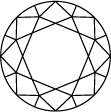
Internally flawless
VVS 1
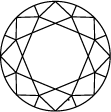
VVS 2
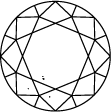
Very very slightly included
VS 1
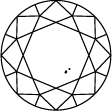
VS 2
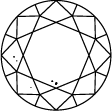
Very slightly included
SI 1
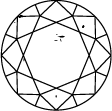
SI 2

Slightly included
I 1

I 2
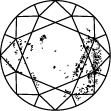
I 3
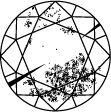
Included
Diamond Clarity Chart
Title:Diamond clarity scale and grades
Legenda:
The diamond clarity scale runs from I.F. to I 3 and is based on the number of inclusions and blemishes found in each stone. Diamond clarity grades are determined under standard viewing conditions with 10x magnification; I.F. is used to represent an internally flawless diamond, while at the other end of the diamond clarity chart, I 3 stands for the inclusion of a visible blemish. Truly flawless diamonds are extremely rare – almost all stones, including laboratory grown diamonds, have inclusions of some kind or other.
Cut Principles and Factors
Title:
The quality of how a laboratory grown diamond is cut is based on its proportions, symmetry, and polish. An expert cut creates a multitude of facets, absorbing and reflecting the light so the stone shimmers from every angle.
Colorless

D-F
Near colorless
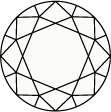
G-J
Slightly tinted

K-M
Very light color

N-R
Light color

S-Z
Diamond color scale and chart
Diamond coloring is rated on a scale from D to Z, with D clear ice white with no hint of yellow, while those rated Z are shades of yellow and brown. Each letter range on the chart denotes a shade of stone, with those rated D to F appearing colorless, through to S to Z appearing in shades of light yellow or brown. Swarovski only accepts the finest laboratory grown diamonds in its collections, meaning they range from colorless to nearly colorless diamonds (D-G).
Color Principles and Factors
Title:
Colorless stones are the most desirable in the world of diamonds and they are extremely rare. Swarovski Created Diamonds are evaluated against the standardized diamond color scale.

2.5 mm
0.05 CT

3.0 mm
0.10 CT

3.8 mm
0.20 CT

4.5 mm
0.30 CT

4.8 mm
0.40 CT

5.2 mm
0.50 CT

5.8 mm
0.70 CT

6.3 mm
0.90 CT

6.5 mm
1.00 CT

6.9 mm
1.25 CT

7.4 mm
1.50 CT

7.8 mm
1.75 CT

8.2 mm
2.00 CT

8.8 mm
2.50 CT

9.4 mm
3.00 CT
Diamond Carat Weight
Title:Laboratory Grown Diamond Carat Scale
Legenda:
The carat measurement is derived by the word ‘carob’, a seed that was used as a diamond weight reference for traders in the ancient world. Carats are an international standard unit of measurement for the weight of a diamond. One carat is equal to 200 milligrams, so a 5 carat diamond will weigh one gram. The diamond carat does not refer to the size of a stone, simply how much it weighs. Diamonds usually become more expensive as their carat increases.
Discover Swarovski Created Diamonds
盡在 Swarovski Created Diamonds
Title:培育鑽石
Legenda:
探索 Swarovski Created Diamonds 首飾的世界,以融合傳統與現代潮流的非凡系列,重新定義鑽石的未來。從璀璨奪目的 Galaxy 系列,到我們優雅的標誌性作品,您一定能找到適合終生佩戴的款式。
培育鑽石購買指南
Title:搜尋作品
Legenda:
Swarovski Created Diamonds 首飾是採用培育鑽石,是我們品牌 DNA 自然發展的結果,精工切割,色澤璀璨,除來源外,與開採出來的鑽石在其他方面完全相同。它們由鑽石種晶層層疊加形成,充分展現大自然的光芒。
培育鑽石是什麼?
Title:培育鑽石的解釋
Legenda:
了解更多關於培育鑽石的資訊,以及如何複製鑽石在地球上形成的過程。探索 Swarovski Created Diamonds中不同切割方式的培育鑽石,以及設計背後的靈感來源。
常見問題
鑽石 4C FAQ
4C 是什麼?
每一顆鑽石都略有不同,都有各自的顯著特徵。培育鑽石除來源外與開採的鑽石在其他方面無異,因此我們的培育鑽石也是根據鑽石分級的 4C 標準進行評估。4C 是指顏色、淨度、切割和克拉重量,是全球公認的評估鑽石品質的標準。
鑽石淨度重要嗎?
淨度分級越高,鑽石的內含物或瑕疵就越少,其價值也就比分級低的鑽石高。
什麼是最高的鑽石淨度?
鑽石淨度是根據內含物和瑕疵這兩種特徵的可見度來衡量鑽石純淨度的等級。
為評估淨度,鑽石要在 10 倍的放大鏡下進行檢查。外部 (瑕疵) 和內部特徵 (內含物) 的數量和性質,以及它們的大小和位置,決定了鑽石的等級。
寶石學家對鑽石進行了分級,從最高品質的內無瑕 (IF) 到內含物 (I3) 。
為評估淨度,鑽石要在 10 倍的放大鏡下進行檢查。外部 (瑕疵) 和內部特徵 (內含物) 的數量和性質,以及它們的大小和位置,決定了鑽石的等級。
寶石學家對鑽石進行了分級,從最高品質的內無瑕 (IF) 到內含物 (I3) 。
培育鑽石是完美無瑕的嗎?
不是,幾乎所有的鑽石 (開採的或實驗室培育的) 都有內含物。培育鑽石可能會含有金屬雜質。如果專家在鑽石中發現金屬痕跡,便可以假定這是培育鑽石。雖然培育的鑽石確實存在瑕疵,但 Swarovski Galaxy 系列只選用經由IGI國際寶石研究院根據 4C 標準認證的優質培育鑽石,以確保 Swarovski Created Diamonds採用的都是品質優良的鑽石。
培育鑽石會變混濁嗎?
不會,培育鑽石不會隨著時間的推移而變得混濁。除了來源,它們與開採鑽石在其他方面100% 相同,具有相同的物理和化學特性,不會隨著時間的推移而退化或改變外觀。若使用品質不佳的鑽石種晶,某些實驗室培育的鑽石會有明顯的缺陷,例如:因鑽石中的雜質或晶體結構不完善造成的色差。Swarovski Created Diamonds 首飾所採用的培育鑽石具有極高的品質標準,不會出現反常或有問題的特徵。
培育的鑽石如何認證和分級?
Swarovski Created Diamonds 首飾中的培育鑽石均由經驗豐富的寶石學家手工挑選和檢驗,以確保這些鑽石符合我們的高品質標準。 Galaxy 和 Eternity 系列的每一件首飾都附有IGI國際寶石研究院的數位實驗室報告。
什麼是鑽石切刻面?
鑽石切刻面是指構成鑽石形狀的每個平面。每顆鑽石都有多個切刻面,使其能夠吸收和反射光線。
如何判定鑽石的切割品質?
我們通常認為鑽石的切割是指鑽石的切割形狀 (圓形、心形、橢圓形、橄欖形、梨形) ,但鑽石切割實際上指的是鑽石切割面與光線的相互作用。 鑽石的切割是衡量鑽石形狀、幾何形狀和表面處理的品質。 圓形明亮式切割鑽石的切割等級從理想 (最好) 到不良都有。 Swarovski 對切割品質毫不妥協,以確保我們所有的培育鑽石都具有出色的光線效果和閃耀程度。
什麼是最佳鑽石切割?
切割是指鑽石的切割面如何與光線相互作用,以顯示其內部的火光。切割的程序賦予每顆鑽石各自的獨特性,Swarovski Created Diamonds 培育鑽石出衆的比例、對稱性和精準的切割角度讓鑽石綻放璀璨的光芒。最佳的切割方式是在寬度和深度之間取得平衡,以形成對稱,既不會太淺,也不會太深。這會讓光線在穿過鑽石時創造精巧的折射點,將光線反射到鑽石內部,增強鑽石璀璨耀眼的亮度。
如何判定鑽石的顏色?
顏色是指白鑽固有的天然色調。顏色分級的產業標準是將每顆鑽石與對照組鑽石進行對比評估,然後提供以英文字母 D (無色) 到 Z (淺黃色或棕色) 的區分等級。
鑽石越接近無色,品質就越好。
鑽石越接近無色,品質就越好。
實驗室製造的鑽石會有瑕疵嗎?
若使用品質不佳的鑽石種晶,某些實驗室培育的鑽石會有明顯的缺陷,例如:因鑽石中的雜質或晶體結構不完善造成的色差。Swarovski 不會販售具有反常、有問題特徵的培育鑽石。
什麼是鑽石克拉重量?
克拉是一種重量單位,專門用來衡量包括培育鑽石在內的珍貴寶石。克拉數較高的鑽石,外觀看起來並不一定較大;兩顆克拉數相同的鑽石,如果其中一顆切割得比另一顆深,它們的大小會不相同。一克拉的重量是 0.2 公克,區分成 100 分。
鑽石的克拉重量是什麼?如何測量,重要性為何?
克拉重量是鑽石的標準重量單位,也是分級過程的第一步。鑽石克拉重量是衡量鑽石重量的單位。每克拉可細分為 100“分”。 這樣在測量重量時就可以精確到小數點後兩位。小於一克拉的鑽石重量可以只用“分”來描述。鑽石越大,克拉重量就越多,但只有您才能決定這對您來說有多重要。
鑽石的克拉重量愈大愈好?
這完全是取決於個人的問題。如果您正在尋找一顆較大的鑽石,您應該尋找克拉數較高的鑽石,因為克拉數表示鑽石的重量,因此也表示鑽石的大小。






